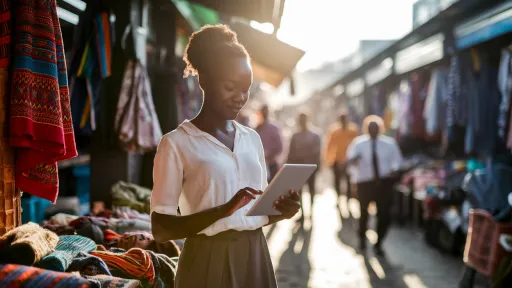
Uganda, nestled in East Africa, is witnessing a transformative phase in its financial technology (FinTech) sector, particularly with a focus on enhancing financial inclusion in its remote and rural areas. This survey note provides a comprehensive analysis of the current FinTech landscape, key players, and the governmental policies that facilitate FinTech growth, with a special emphasis on their impact on remote communities.
Uganda’s vision for a digital economy aims for a diverse, sustainable, and digital future, aligning with broader regional aspirations. The digital economy currently contributes approximately 7% to the gross domestic product (GDP), outpacing some regional peers. This growth is crucial given the country’s mobile penetration rate of 49%, with only 16% of Ugandans owning smartphones, necessitating accessible solutions like USSD-based services for financial inclusion.
Current State of FinTech in Uganda
The FinTech sector in Uganda is characterized by a robust ecosystem, with mobile money services at its core. The sector’s composition includes:
- Payments: Accounting for 47% of FinTech activities, dominated by mobile money platforms like Airtel Money, MTN Mobile Money, and Eversend.
- Banking Infrastructure: Comprising 23%, these FinTechs enhance digital banking services, making them more accessible.
- Investments and Savings: At 16%, digital platforms are emerging to cater to investment and savings needs.
- Lending: Representing 7%, digital lenders provide credit solutions, particularly to rural small and medium-sized enterprises (SMEs) and individuals.
- Insurance: At 5%, and Markets: At 2%, these segments are growing but less dominant.
Key players include:
- Yo-Uganda Limited: A long-established mobile payments aggregator, licensed by the Central Bank, it processes payments for various sectors and has digitized agriculture by onboarding 200,000 farmers in six months.
- Akellobanker: Serves over 49,000 rural farmers and traders, disbursing USD 350,000 in loans, directly targeting rural financial inclusion.
- Everpesa Technologies: Advances financial inclusion and sustainability across rural Uganda through platforms like SafariBanking, digitizing banking processes for Savings and Credit Cooperative Organizations (SACCOs) and microfinance institutions (MFIs).
E-commerce has also grown, particularly during the COVID-19 pandemic, with platforms like Safeboda, Jumia, and Glovo expanding, though concentrated in urban centers like Kampala due to higher smartphone usage. Remittances, facilitated by mobile money, have surged, with over 30 million registered customers in 2020, up from 0.6 million in 2015, and transaction values reaching UGX 79.8 trillion, up from UGX 133 billion in 2015, indicating significant rural engagement.
Government Policies and Regulatory Framework
The Ugandan government has implemented several policies to foster FinTech growth, indirectly benefiting remote communities by promoting financial inclusion:
- National Financial Inclusion Strategy (NFIS) 2017-2022: Launched to reduce financial exclusion from 15% to 5% by 2022, the strategy is built on five pillars:
- Reducing financial exclusion and barriers to access financial services.
- Developing the credit infrastructure for growth.
- Building the digital infrastructure for efficiency.
- Deepening and broadening formal savings, investment, and insurance usage.
- Protecting and empowering individuals with enhanced financial capability. While not explicitly targeting rural areas, the focus on digital infrastructure and access aligns with rural needs.
- National Payment Systems Act: Enacted to regulate payment service providers, electronic money issuers, and payment system operators, ensuring secure and efficient transactions, vital for rural mobile money adoption.
- Regulatory Sandbox: The Bank of Uganda uses a regulatory sandbox to allow FinTech companies to test innovations in a controlled environment, fostering solutions for remote areas.
- Mobile Money Guidelines: Issued by the Bank of Uganda, these guidelines have facilitated the growth of mobile money services since 2009, with updates in 2013, crucial for rural financial inclusion given the high mobile penetration and low smartphone ownership.
Specific Initiatives and Impact on Remote Communities
While there are no explicitly stated government programs solely for FinTech in rural areas, the general policies have created an enabling environment for FinTech companies to expand into remote communities:
- Digital Financial Services (DFS): Supported by the NFIS, DFS enabled by FinTech lower costs, increase speed, security, and transparency, serving the underserved at scale, particularly in rural areas where traditional banking is inaccessible.
- Mobile Money Expansion: The government’s regulatory framework has supported telecom companies like Airtel and MTN to include financial services, significantly impacting rural areas by providing accessible banking solutions.
- Financial Literacy and Partnerships: Initiatives like Smart Money International provide mobile savings, payment services, and financial literacy training to rural communities, supported by the enabling policy environment.
The impact on remote communities includes increased access to financial services, enhanced financial inclusion, and fostered economic growth. Mobile money has been a game-changer, with over 30 million registered customers by 2020, demonstrating significant rural adoption despite low smartphone usage—a surprising detail given the infrastructure challenges.
Challenges and Opportunities
Challenges include limited connectivity in rural areas, with over 50% of Internet users expected from rural areas by 2025, and low digital literacy, necessitating USSD-based solutions and partnerships with community leaders for education. Opportunities lie in the viable market of 6 million people, with companies like Everpesa Technologies and Akellobanker directly targeting rural financial needs, supported by government policies promoting competition and innovation.
Conclusion
Uganda’s FinTech landscape is robust, driven by mobile money and digital banking, with government policies like the NFIS and regulatory frameworks creating an enabling environment. While not explicitly targeting rural areas, these policies indirectly support FinTech expansion into remote communities, enhancing financial inclusion and economic growth. The surprising scale of mobile money adoption, with over 30 million users by 2020, underscores the potential for further development, particularly with improved rural connectivity and literacy initiatives.